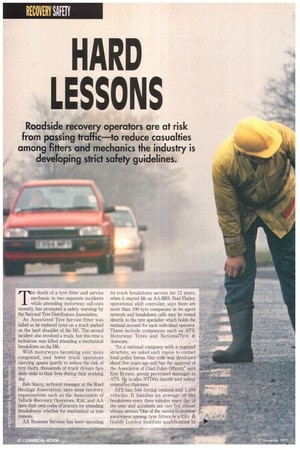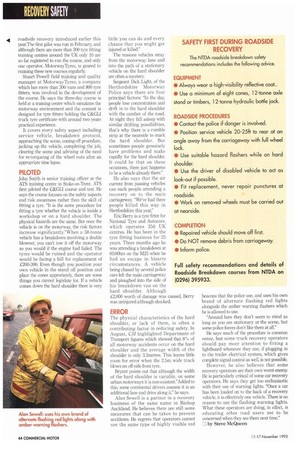HARD LESSONS
Page 44

Page 46

If you've noticed an error in this article please click here to report it so we can fix it.
re death of a tyre fitter and service mechanic in two separate incidents while attending motorway call-outs recently, has prompted a safety warning by the National Tyre Distributors Association, An Associated Tyre Service fitter was killed as he replaced tyres on a truck parked on the hard shoulder of the Ml. The second incident also involved a truck, but this time a technician was killed attending a mechanical breakdown on the M6.
With motorways becoming ever more congested, and fewer truck operators carrying spares (partly to reduce the risk of tyre theft), thousands of truck drivers face daily risks to their lives during their working day Bob Stacey, technical manager at the Road Haulage Association, says most recovery organisations such as the Association of Vehicle Recovery Operators, RAC and AA have their own codes of practice for attending breakdowns whether for mechanical or tyre reasons.
AA Business Services has been operating its truck breakdown service for 12 year:-.. when it started life as AA-BRS. Noel Flatley, operational shift controller, says there are more than 100 tyre companies in its agent network and breakdown calls may be routed directly to the tyre specialist which holds the national account for each individual operator. These include companies such as ATS, Motorway Tyres and NationalTyre & Autocare.
"As a national company with a regional structure, we asked each region to contact local police forces, Our code was developed about five years ago and has the approval of the Association of Chief Police Officers," says Ken Bryant, group personnel manager at ATS. He is also NTDA's health and safety committee chairman.
ATS has 546 fitting centres and 1,100 vehicles. It handles an average of one breakdown every three minutes every day of the year and accidents are rare but almost always serious."One of the moves to increase awareness among tyre fitters is a City & Guilds London Institute qualification in roadside recovery introduced earlier this year.The first pilot was run in February, and although there are more than 200 tyre fitting training centres around the UK only 10 are so far registered to run the course, and only one operator. MotorwayTyres, is geared to running these new courses regularly Stuart Powell field training and quality manager at MotorwayTyres, a company which has more than 300 vans and 800 tyre fitters, was involved in the development of the course. He says the three-day course is held at a training centre which simulates the motorway environment and the content is designed for tyre fitters holding the C&GLI truck tyre certificate with around two years practical experience.
It covers every safety aspect including service vehicle, breakdown protocol, approaching the scene, coning-off procedure, jacking up the vehicle, completing the job, clearing the scene and advising of the need for re-torqueing of the wheel nuts after an appropriate time lapse.
PILOTED
John Smith is senior training officer at the ATS training centre in Stoke-on-Trent. ATS first piloted the C&GLI course and test. He says the course focuses on the safety aspects and risk awareness rather than the skill of fitting a tyre. "It is the same procedure for fitting a tyre whether the vehicle is inside a workshop or on a hard shoulder. The physical hazards are the same. But once the vehicle is on the motorway, the risk factors increase significantly."When a 38-tonne vehicle has a breakdown involving a double blowout, you can't tow it off the motorway as you would if the engine had failed. The tyres would be ruined and the operator would be facing a bill for replacement of £200-300. Even though you position your own vehicle in the stand off position and place the cones approriately, there are some things you cannot legislate for. If a vehicle comes down the hard shoulder there is very little you can do and every chance that you might get injured or killed."
The reasons vehicles stray from the motorway lane and into the path of a stationary vehicle on the hard shoulder are often a mystery.
Sergeant Dick Light, of the Hertfordshire Motorway Police says there are four principal factors: "In the day, people lose concentration and drift in to the hard shoulder with the camber of the road. At night they fall asleep with similar drifting possibilities, that's why there is a rumble strip at the nearside to mark the hard shoulder. But sometimes people genuinely have problems and make rapidly for the hard shoulder. It could be that on these occasions, there just happens to be a vehicle already there."
He also says that the air current from passing vehicles can suck people attending a recovery on to the main carriageway. "We've had three people killed this way in Hertfordshire this year," COMPLETION • Inform police. Eric Berry is a tyre fitter for National Tyre and Autocare, which operates 356 UK centres. He has been in the tyre fitting business for 25 years. Three months ago he was attending a breakdown at 05:00hrs on the M25 when he had an escape in bizarre circumstances. A vehicle being chased by several police cars left the main carriageway and ploughed into the side of his breakdown van on the hard shoulder. Although £2,000 worth of damage was caused, Berry was uninjured although shocked.
ERROR
The physical characteristics of the hard shoulder, or lack of them, is often a contributing factor in reducing safety. In August, CM highlighted Department of Transport figures which showed that 8% of all motorway accidents occur on the hard shoulder and the average width of the shoulder is only 3.3metres. This leaves little room for error when the 2.5m wide truck blows an off-side front tyre.
Bryant points out that although the width of the hard shoulder is variable, on some urban motorways it is non-existent."Added to this, some continental drivers assume it is an additional lane and drive along it," he says.
Alan Sewell is a partner in a recovery business of the same name in Bishop Auckland. He believes there are still some measures that can be taken to prevent accidents. He regrets that operators cannot use the same type of highly visible red beacons that the police use, and uses his own brand of alternate flashing red lights alongside the amber warning flashers which he is allowed to use.
'Around here they don't seem to mind as long as you are stationary at the scene, but some police forces don't like them at all."
He says much of the procedure is common sense, but some truck recovery operators should pay more attention to fitting a lightboard whenever they can, if plugging in to the trailer electrical system, which gives complete signal control as well, is not possible.
However, he also believes that some recovery operators are their own worst enemy. He is particularly critical of some car recovery operators. He says they get too enthusiastic with their use of warning lights. "Once a car has been loaded on to the back of a recovery vehicle, it is effectively one vehicle. There is no reason to use the flashing warning lights. What these operators are doing, in effect, is educating other road users not to be concerned when they see them next time."
by Steve McQueen




















































































